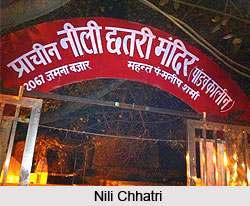 Nili Chhatri Temple is a Hindu temple located in New Delhi. The temple is dedicated to Lord Shiva. According to mythology the temple was established by King Yudhisthir, the eldest of the Pandavas. He also constructed the Nigambodh Ghat located in the vicinity of the temple. It is from here he conducted the Aswamedha yajna. The temple is situated on the banks of Yamuna River in the Yamuna bazaar area. As per historical records Nili Chhatri was the tomb of Naubat Khan who was a mansabdar or state official during the rule of the Mughal Emperor Akbar. He built it during his lifetime in 1565. The tomb stands almost midway between Purana Quila and the tomb of Hajrat Nizamuddin Auliya.
Nili Chhatri Temple is a Hindu temple located in New Delhi. The temple is dedicated to Lord Shiva. According to mythology the temple was established by King Yudhisthir, the eldest of the Pandavas. He also constructed the Nigambodh Ghat located in the vicinity of the temple. It is from here he conducted the Aswamedha yajna. The temple is situated on the banks of Yamuna River in the Yamuna bazaar area. As per historical records Nili Chhatri was the tomb of Naubat Khan who was a mansabdar or state official during the rule of the Mughal Emperor Akbar. He built it during his lifetime in 1565. The tomb stands almost midway between Purana Quila and the tomb of Hajrat Nizamuddin Auliya.
The tomb is known as Nili Chhatri because of the colour of the dome. It was originally embellished with blue caustic tiles. The tomb has been built on several acres of land. The walls of the tomb are now in damaged state but some portions are still visible in the surrounding area. The gateway of the tomb is well maintained and in good shape. An inscription can be seen at the entrance of the gate that has been carved of black marble inlaid on sandstone. Behind the gateway of Nili Chhatri there is a small building. It has three doors. There is also a high octagonal terrace built at the back of the building. It is almost 6 feet (1.8 m) from the ground and 79 feet (24 m) in diameter. There are two flights of steps that have been built in the centre of the southern wall on opposite sides. These steps lead to a landing on a level. One can also see ruins of a tower on all the four corners of the terrace. Two graves of masonry and stone can also be located on the north-eastern and north-western corners of the terrace. In the centre of the `chabutrah` is the octagonal shaped mausoleum of Naubat Khan. It is 51 feet (16 m) as its diameter and about 34 feet (10 m) in height. The tomb has been built of stone and masonry. It looks very attractive being embellished with encaustic tiles of four colours i.e. green, blue, yellow, and orange. The tomb is adorned with eight arched entrances and these are about 5 feet (1.5 m) wide and 7 feet (2.1 m) height. Verses from Holy Quran can be traced in the tomb. Above these doorways there are open arched niches. The walls of the tomb have steps. Upon climbing the first fleet of steps one reaches to the level of the open niches over the doorways. If one climbs the second set of twelve steps he would reach to the top of the building. The roof of the tomb appears to be flat. In the middle there is an octagonal `chabutrah` about 5 feet (1.5 m) high and 30 feet (9.1 m) in diameter. This supports another octagonal `chabutrah` 23 feet (7.0 m) in diameter and about 2 feet (0.61 m) high.





















